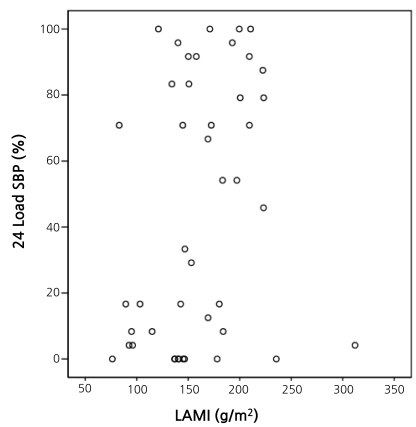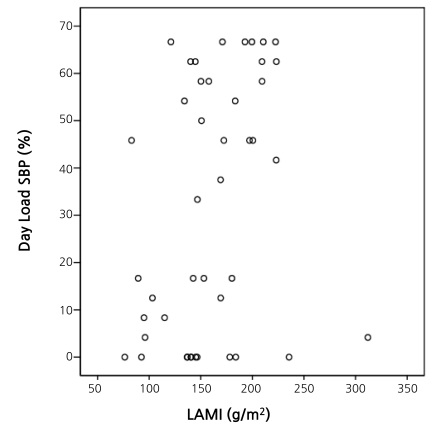Electrolyte Blood Press.
2011 Jun;9(1):16-22. 10.5049/EBP.2011.9.1.16.
Comparison of Blood Pressure Control and Left Ventricular Hypertrophy in Patients on Continuous Ambulatory Peritoneal Dialysis (CAPD) and Automated Peritoneal Dialysis (APD)
- Affiliations
-
- 1Division of Nephrology, Department of Internal Medicine, Chungbuk National University College of Medicine, Cheongju, Korea. hyekim@chungbuk.ac.kr
- KMID: 1497137
- DOI: http://doi.org/10.5049/EBP.2011.9.1.16
Abstract
- This study aimed to investigate the influence of different peritoneal dialysis regimens on blood pressure control, the diurnal pattern of blood pressure and left ventricular hypertrophy in patients on peritoneal dialysis. Forty-four patients undergoing peritoneal dialysis were enrolled into the study. Patients were treated with different regimens of peritoneal dialysis: 26 patients on continuous ambulatory peritoneal dialysis (CAPD) and 18 patients on automated peritoneal dialysis (APD). All patients performed 24-hour ambulatory blood pressure monitoring (ABPM) and echocardiography. Echocardiography was performed for measurement of cardiac parameters and calculation of left ventricular mass index (LVMI). There were no significant differences in average of systolic and diastolic blood pressure during 24-hour, daytime, and nighttime between CAPD and APD groups. There were no significant differences in diurnal variation of blood pressure, systolic and diastolic blood pressure load, and LVMI between CAPD and APD groups. LVMI was associated with 24 hour systolic blood pressure load (r = 0.311, P < 0.05) and daytime systolic blood pressure load (r = 0.360, P < 0.05). In conclusion, this study found that there is no difference in blood pressure control, diurnal variation of blood pressure and left ventricular hypertrophy between CAPD and APD patients. The different peritoneal dialysis regimens might not influence blood pressure control and diurnal variation of blood pressure in patients on peritoneal dialysis.
Keyword
MeSH Terms
Figure
Reference
-
1. Wilson J, Nissenson AR. Determinants in APD selection. Semin Dial. 2002; 15:388–392. PMID: 12437531.2. Brunkhorst R, Wrenger E, Krautzig S, Ehlerding G, Mahiout A, Koch KM. Clinical experience with home automated peritoneal dialysis. Kidney Int Suppl. 1994; 48:S25–S30. PMID: 7700038.3. Holley JL, Bernardini J, Piraino B. Continuous cycling peritoneal dialysis is associated with lower rates of catheter infections than continuous ambulatory peritoneal dialysis. Am J Kidney Dis. 1990; 16:133–136. PMID: 2382649.
Article4. Rodriguez AM, Diaz NV, Cubillo LP, et al. Automated peritoneal dialysis: a Spanish multicentre study. Nephrol Dial Transplant. 1998; 13:2335–2340. PMID: 9761518.
Article5. Hiroshige K, Yuu K, Soejima M, Takasugi M, Kuroiwa A. Rapid decline of residual renal function in patients on automated peritoneal dialysis. Perit Dial Int. 1996; 16:307–315. PMID: 8761546.
Article6. Hufnagel G, Michel C, Queffeulou G, Skhiri H, Damieri H, Mignon F. The influence of automated peritoneal dialysis on the decrease in residual renal function. Nephrol Dial Transplant. 1999; 14:1224–1228. PMID: 10344365.
Article7. Rodriguez-Carmona A, Fontan MP. Sodium removal in patients undergoing CAPD and automated peritoneal dialysis. Perit Dial Int. 2002; 22:705–713. PMID: 12556073.
Article8. Ortega O, Gallar P, Carreno A, et al. Peritoneal sodium mass removal in continuous ambulatory peritoneal dialysis and automated peritoneal dialysis: influence on blood pressure control. Am J Nephrol. 2001; 21:189–193. PMID: 11423687.
Article9. Rodriguez-Carmona A, Perez-Fontan M, Garca-Naveiro R, Villaverde P, Peteiro J. Compared time profiles of ultrafiltration, sodium removal, and renal function in incident CAPD and automated peritoneal dialysis patients. Am J Kidney Dis. 2004; 44:132–145. PMID: 15211446.10. Westra WM, Kopple JD, Krediet RT, Appell M, Mehrotra R. Dietary protein requirements and dialysate protein losses in chronic peritoneal dialysis patients. Perit Dial Int. 2007; 27:192–195. PMID: 17299157.
Article11. Erturk S, Ertug AE, Ates K, et al. Relationship of ambulatory blood pressure monitoring data to echocardiographic findings in haemodialysis patients. Nephrol Dial Transplant. 1996; 11:2050–2054. PMID: 8918721.
Article12. Katzarski KS, Charra B, Luik AJ, et al. Fluid state and blood pressure control in patients treated with long and short haemodialysis. Nephrol Dial Transplant. 1999; 14:369–375. PMID: 10069191.
Article13. Gunal AI, Duman S, Ozkahya M, et al. Strict volume control normalizes hypertension in peritoneal dialysis patients. Am J Kidney Dis. 2001; 37:588–593. PMID: 11228184.14. Phillips RA, Diamond JA. Ambulatory blood pressure monitoring and echocardiography--noninvasive techniques for evaluation of the hypertensive patient. Prog Cardiovasc Dis. 1999; 41:397–440. PMID: 10445867.
Article15. Sahn DJ, DeMaria A, Kisslo J, Weyman A. Recommendations regarding quantitation in M-mode echocardiography: results of a survey of echocardiographic measurements. Circulation. 1978; 58:1072–1083. PMID: 709763.
Article16. Devereux RB, Reichek N. Echocardiographic determination of left ventricular mass in man. Anatomic validation of the method. Circulation. 1977; 55:613–618. PMID: 138494.
Article17. Dubois D, Dubois EF. A formula to estimate the approximate surface area if height and weight be known. Arch Intern Med. 1916; 17:863–871.18. Watson PE, Watson ID, Batt RD. Total body water volumes for adult males and females estimated from simple anthropometric measurements. Am J Clin Nutr. 1980; 33:27–39. PMID: 6986753.
Article19. Twardowski ZJ. Clinical value of standardized equilibration tests in CAPD patients. Blood Purif. 1989; 7:95–108. PMID: 2663040.
Article20. Wang MC, Tseng CC, Tsai WC, Huang JJ. Blood pressure and left ventricular hypertrophy in patients on different peritoneal dialysis regimens. Perit Dial Int. 2001; 21:36–42. PMID: 11280494.
Article21. Ortega O, Gallar P, Carreno A, et al. Peritoneal sodium mass removal in continuous ambulatory peritoneal dialysis and automated peritoneal dialysis: influence on blood pressure control. Am J Nephrol. 2001; 21:189–193. PMID: 11423687.
Article22. Casale PN, Devereux RB, Milner M, et al. Value of echocardiographic measurement of left ventricular mass in predicting cardiovascular morbid events in hypertensive men. Ann Intern Med. 1986; 105:173–178. PMID: 2942070.
Article23. Frohlich ED. Left ventricular hypertrophy as a risk factor. Cardiol Clin. 1986; 4:137–144. PMID: 2939951.
Article24. Anderson KP. Sudden death, hypertension, and hypertrophy. J Cardiovasc Pharmacol. 1984; 6(Suppl 3):S498–S503. PMID: 6208419.
Article25. McLenachan JM, Henderson E, Morris KI, Dargie HJ. Ventricular arrhythmias in patients with hypertensive left ventricular hypertrophy. N Engl J Med. 1987; 317:787–792. PMID: 2957590.
Article26. Levy D, Garrison RJ, Savage DD, Kannel WB, Castelli WP. Prognostic implications of echocardiographically determined left ventricular mass in the Framingham Heart Study. N Engl J Med. 1990; 322:1561–1566. PMID: 2139921.
Article27. Silaruks S, Sirivongs D, Chunlertrith D. Left ventricular hypertrophy and clinical outcome in CAPD patients. Perit Dial Int. 2000; 20:461–466. PMID: 11007379.
Article28. Chung JH, Yun NR, Ahn CY, Lee WS, Kim HL. Relationship between serum N-terminal pro-brain natriuretic peptide level and left ventricular dysfunction and extracellular water in continuous ambulatory peritoneal dialysis patients. Electrolyte Blood Press. 2008; 6:15–21.
Article29. Sturrock ND, George E, Pound N, Stevenson J, Peck GM, Sowter H. Non-dipping circadian blood pressure and renal impairment are associated with increased mortality in diabetes mellitus. Diabet Med. 2000; 17:360–364. PMID: 10872534.
Article30. White WB. How well does ambulatory blood pressure predict target-organ disease and clinical outcome in patients with hypertension? Blood Press Monit. 1999; 4(Suppl 2):S17–S21. PMID: 10822418.
Article31. Covic A, Goldsmith DJ, Covic M. Reduced blood pressure diurnal variability as a risk factor for progressive left ventricular dilatation in hemodialysis patients. Am J Kidney Dis. 2000; 35:617–623. PMID: 10739781.
Article32. Verdecchia P, Angeli F, Borgioni C, Gattobigio R, Reboldi G. Ambulatory blood pressure and cardiovascular outcome in relation to perceived sleep deprivation. Hypertension. 2007; 49:777–783. PMID: 17261645.
Article33. Struijk DG, Krediet RT. Sodium balance in automated peritoneal dialysis. Perit Dial Int. 2000; 20(Suppl 2):S101–S105. PMID: 10911653.
Article
- Full Text Links
- Actions
-
Cited
- CITED
-
- Close
- Share
- Similar articles
-
- Peritoneal-pleural leak improved by switching from continuous ambulatory peritoneal dialysis to automated peritoneal dialysis
- Clinical Comparison of Automated Peritoneal Dialysis with Continuous Ambulatory Peritoneal Dialysis
- Spontaneous Renal Rupture with Hemoperitoneum in a Patient on Continuous Ambulatory Peritoneal Dialysis
- Peritonitis due to Leclercia adecarboxylata in a Patient Receiving Automated Peritoneal Dialysis
- Clinical Usefulness of Automated Peritoneal Dialysis (APD) in End Stage Renal Disease Patients



